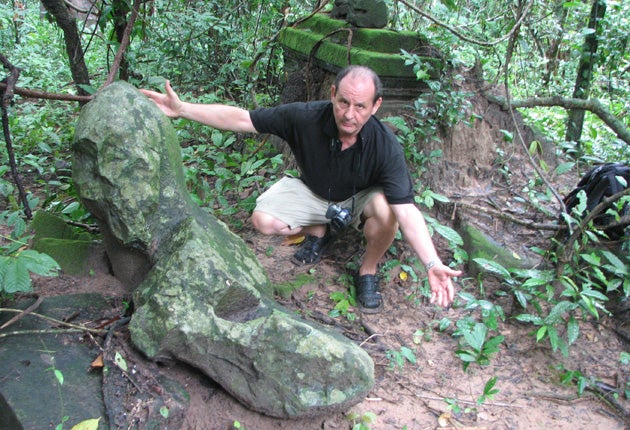British 'Indiana Jones' finds missing legs of 900-year-old Buddhist statue

It sounds like the plot of an Indiana Jones movie: an archaeology professor with little more to go on than a yellowing photograph discovers part of a 900-year-old statue deep in the Cambodian jungle, rewriting history in the process.
Dr Peter Sharrock, a senior teaching fellow in the art and archaeology of Southeast Asia at London's School of Oriental and African Studies, was at a conference in Cambodia in July when he decided to spend a day searching the forest around the ruins of Angkor.
His aim was to locate the missing giant legs of an eight-headed, three-metre high sandstone statue of Hevajra, the war-like, tantric Buddhist deity. The statue's intricately carved bust was excavated and salvaged in 1925 by French archaeologists, who sold it to the Metropolitan Museum of Art in New York, where it has been on display ever since. The rest of the statue had not been found – until now.
Armed only with photos of the excavations taken by the French 84 years ago, Dr Sharrock and his friend David Green trekked into the forest outside one of the ancient city's gates "where no tourist goes". He cannot reveal the exact location of the site due to fears of looting.
"There was no road, only a sort of animal track into the forest," he said. "It was pretty unpleasant. There were snakes all over the place, and in the back of my mind was the knowledge that the Khmer Rouge had planted land mines all over Angkor.
"We went on and on, and were about to give up, when finally I spotted something through the trees. We strode through the creepers and thorns, and I realised that I'd seen the carved square corner of the statue's pedestal. And lo and behold, there were the legs lying beside it."
Many parts of the 12th-century statue – including all 16 of its arms and one of its heads – are still missing, but Cambodia's government has now pledged to excavate the site.
Hevajra would have been venerated during the reign of Jayavarman VII, emperor of the Khmers at the height of their power, but it is likely the statue was broken up and dumped outside the city walls during a revival of Hinduism in the 14th century. This theory undermines the view that the Khmers followed a compassionate Buddhist philosophy. "It's something of a tectonic shift in archaeology", Dr Sharrock said.
Join our commenting forum
Join thought-provoking conversations, follow other Independent readers and see their replies
Comments